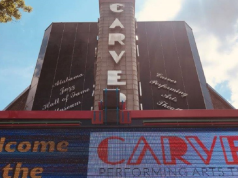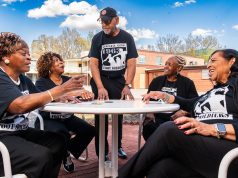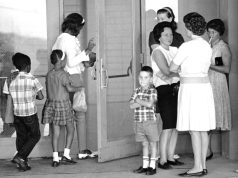By Michael Tomberlin
Alabama Newscenter
One of downtown Birmingham’s largest vacant buildings could see new life as 192 workforce housing apartments after a $30 million renovation.
The five-story, 140,000-square-foot former American Red Cross building at 2225 Third Ave. N. has been vacant since the organization moved out in 1999.
The development team behind the $24 million revitalization of the American Life building will tackle the American Red Cross building using a similar blueprint.
“American Life has been so well-received. It’s like a dream for us,” said owner and developer Ed Ticheli. “We’re going to repeat the same program here.”
That program is a combination of private investment through opportunity zone funding and public dollars, such as a Housing and Urban Development loan.
Though final designs aren’t complete, Ticheli expects the apartments will range in size from 300 square feet to 650 square feet. They will have affordable rents and be designed to appeal to young families, young professionals and college students.
As with the American Life building, some units in the American Red Cross building will be devoted to the Dannon Project to rent to clients. The Birmingham nonprofit helps people reintegrate into the workforce after prison or other obstacles.
Also like the American Life building, pulling off the development requires a team.
“There are a lot of hands on the rope,” Ticheli said.
Working with Ticheli are LMS Real Estate Investment Management, Hendon & Huckestein Architects, Wyatt Builds, Gladstone Equity Partners, Baker Donelson, Bradley, PNC Bank, Citizens Bank and First Avenue Funding.
Additionally, Opportunity Alabama, REV Birmingham and the mayor’s office have provided support for the project.
Birmingham Mayor Randall Woodfin said removing such a large eyesore as the American Red Cross building is only part of the story.
“I will tell you when you do revitalization to a building like this, you’re not only removing blight, but you’re creating foot traffic in the entire area,” he said. “You’re also bringing jobs and there are so many other things you’re doing around economic development that’s growing our city. So this is an overwhelming positive for our community.”
Before it was the five-story American Red Cross building dating back to 1975, it was the two-story former Social Security Administration building dating back to the 1940s. That creates some interesting challenges, according to Erik Hendon, principal with Hendon & Huckestein Architects.
“It’s got one of the most interesting structural systems that we’ve seen,” Hendon said. “It started off as a one-story building, they added a second story and then years later the American Red Cross came and put another building over the top of it. So, we’ve got a middle floor that used to be a roof.”
Hendon said that presents a challenge to put in residential units with the existing columns and current floor plans.
“But the bones of the building are good,” he said. “We’ve just got to figure out all of the systems.”
Ticheli said he hopes to have the HUD loan in place by the third quarter of next year and then construction will be underway. Work could then take over a year.
“On something this size it can go anywhere from 14 to 16 months,” said Nick Miele, president of Wyatt Builds. “Anytime we get to touch a building downtown, it’s a new adventure.”

Ticheli said residents will begin moving into the 140 apartments at the 12-story American Life building in October of this year. There is pre-planning for a second phase of the American Life building that would add another 350 apartments along with retail and service spaces.
American Life is a block away from the American Red Cross building and Ticheli sees synergy between the two projects.
“You will start to see this whole little neighborhood just explode with energy and young people and seniors and intergenerational living and vets and just everybody I can get in here,” Ticheli said.
David Fleming, president and CEO of REV Birmingham, said large projects bring about great change.
“The density that this kind of project brings is what makes cities really hum,” Fleming said of the American Red Cross building. “So this project’s density is going to really bring a lot more vibrancy to our downtown.”
It also takes a vacant piece of property and makes it productive again, Fleming said.
“It’s very exciting to see this plan come together to meet a real need for our city, which is additional housing, residential, targeting the workforce and it will bring more vibrancy to this block,” he said.
Whether it’s more money for schools or greater economic development, Woodfin said projects downtown have a positive effect on the whole city.
“It means vitality,” he said. “It means the right investments are being made not only in our central district, but they’re getting spread out across the entire city and 99 neighborhoods.”
Woodfin said the city lobbied to get as many areas designated as opportunity zones as possible. Such a designation allows for the public sector to invest in revitalization projects and receive attractive tax benefits on the returns on their investments.
The American Life building is being held up as a model for opportunity zones projects across the country and the American Red Cross project could have similar potential if it closes on similar investments.

Fleming, whose organization is focused on revitalizing downtown and urban neighborhoods, said opportunity zones are an important tool in the tool bag because they allow for better targeting the needs of a neighborhood.
The double shot of American Life and American Red Cross amplifies that potential.
“I think that this east side of downtown has matured a lot, but it’s got a lot more to do and a lot more to go,” Fleming said. “This project in light of some of the projects around really helps fill some gaps in this part of downtown and it’s really pleasing to see the gaps fill in.”
For Woodfin, it’s another example of progress.
“Let’s keep moving Birmingham,” he said. “Let’s keep making the right necessary economic investments and the returns we see will be the improvement on the quality of life for all that live in and enjoy our city.”





